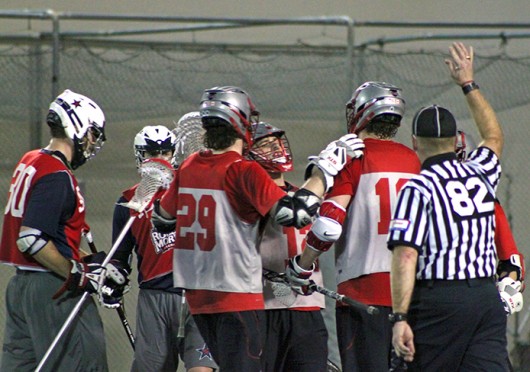
Members of the OSU men’s lacrosse team celebrate a goal during a game against Robert Morris Feb. 1 at the Woody Hayes Athletic Center. OSU won, 11-7.
Credit: Ryan Robey / For The Lantern
The transition from being a high school athlete to a career in college could be difficult, but the utilization of resources in college could help balance academics and athletics.
A senior defender for the Ohio State men’s lacrosse team, Joe Meurer — who is set to graduate in May — said the time and effort he has put in with lacrosse compared to high school has increased drastically.
“In high school you’re probably committing, you know, eight hours a week to lacrosse, here you’re committing double,” Meurer said.
Some OSU athletes said with practice taking up a large amount of student-athletes’ time, getting support with classwork becomes essential.
“I think high school is not nearly as demanding as college is, and you don’t have to make as many sacrifices as you do as a college student-athlete,” redshirt-junior goalkeeper for the OSU men’s soccer team Alex Ivanov said.
OSU’s Student-Athlete Support Service Office seeks to aid student-athletes academically. The program supports about 1,000 student-athletes a year, associate director and athletic academic counselor for SASSO Vicki Melnick said in an email. Melnick said the program’s funding comes from the Office of Undergraduate Education, which amounts to about $2.6 million in the current fiscal year.
Melnick said that the programs goal is to help students to stay the course.
“Our office focuses primarily on academic support, and then also what we call student development support, primarily in the areas of career developments and some personal development along with leadership development,” Melnick said.
Athletes are required to attend study table sessions in the Younkin Success Center located at 1640 Neil Avenue, for a time to study and do schoolwork. Requirement hours for study table vary depending on the sport. The head coaches with the assistance from academic counselors decide on the amount of weekly hours needed for study table for that particular athlete. Melnick said in an interview with The Lantern that only freshman are required to have study tables and that the average time spent on the table is six to eight hours a week.
“Typically, it’s predominantly first-year students. One of the main purposes of it is to help them transition into college,” Melnick said. “To see the value of making sure they spend the minimum amount of time each week studying.”
Ivanov became the first Academic All-American for the men’s soccer program this past season. Even as a fourth-year, he utilizes tutor facilities offered by SASSO to help maintain his grades as an electrical and computer engineering major.
“I used to do the study table hours then the other years it’s all been on my own, just trying to meet people in class and stuff, like a normal student would, and if I ever did need a tutor for like a special math class or something, I could go to Younkin or SASSO to set something up for me,” Ivanov said.
SASSO not only support student-athletes in the transition into college, but also prepares them for what comes after.
“We have two classes that we teach that are designed for student-athletes. One is helping student-athletes transitioning into college, so it covers a variety of topics like nutrition, time management, a little bit of money management, study skills, introduces them to various help services around campus and athletic departments outside our office,” Melnick said. “The other course is designed for upperclassmen and it’s a ‘transition out of college’ class.”
Some student-athletes at OSU are grateful for the support given to them.
“It’s been really beneficial. Since day one I’ve been here and I’ve definitely utilized it to my full potential,” Meurer said.


